Christian Friedrich Schwarz

Christian Frederick Schwarz (with spellings including Friedrich and Schwartz or Swartz) (8 October 1726 – 13 February 1798) was a German
Life


Christian was born on 8 October (sometimes given as 22 or 26 October 1726) at
He arrived at
There was an explosion of the ammunition dump of East India company in 1761. A lot of Native soldiers died in that explosion, and he established Bishop Heber School in Trichinopoly for the soldiers' orphaned children. Again there was another ammunition dump explosion in Trichinopoly in 1763. In which all the British soldiers and their wives perished. Only 14 children of the soldiers survived and Schwarz started a school in the Vestry of St. John's Church which had been built by the British soldiers. Later the army gave some land, about five acres adjoining the army garrison to build a proper school. The school was built British army personnel and civilians who were Freemasons.[citation needed]
In 1769, he secured the friendship of the king Raja Tuljaji, who, although he never converted to Christianity, afforded him every countenance in his missionary labours. Shortly before his death he committed to Schwarz the education of his adopted son and successor Sarabhoji (Serfoji).[6] Schwarz taught the prince, Prince Serfoji, and another slightly older pupil Vedanayagam[1] using the gurukulam approach, where the teacher and the pupil live together. Raja Serfoji built a church to show his affection to Schwartz and it is still seen as a symbol of tolerance on the part of that great Mahratta ruler towards different religions.
In 1779, Schwarz undertook, at the request of the British authorities in
Legacy
Schwarz's direct success in making converts exceeded that of any other Protestant missionary in India, in addition to which he succeeded in winning the esteem of
The following is the wording of the Memorial commissioned by Raja Serfoji
To the memory of the Reverend Christian Frederic Swartz. Born at Sonnenburg of Neumark in the Kingdom of Prussia, the 26th of October 1726, and died at Tanjore the 13th of February 1798, in the 72d Year of his age. Devoted from his Early Manhood to the Office of Missionary in the East, the similarity of his situation to that of the first preachers of the gospel, produced in him a peculiar resemblance to the simple sanctity of the apostolic character. His natural vivacity won the affection as his unspotted probity and purity of life alike commanded the reverence of the Christian, Mahomedan and Hindu. For sovereign princes, Hindu, and Mahomeden selected this humble pastor as the medium of political negotiations with the British Government - Maha Raja Serfojee
-
Memorial to Schwartz byTanjore
-
Replica of the Schwartz Memorial at the Tanjore Palace Museum
-
Memorial Stone at the CSI Schwartz Memorial Church, Tanjore
-
CSI Schwartz Memorial Church, Tanjore
-
Interiors of the CSI Schwartz Memorial Church, Tanjore
-
Side View of the CSI Schwartz Memorial Church, Tanjore
Further reading
- Werner Raupp (Hrsg.): Mission in Quellentexten. Geschichte der Deutschen Evangelischen Mission von der Reformation bis zur Weltmissionskonferenz Edinburgh 1910, Erlangen/Bad Liebenzell 1990, S. 138–163, bes. 160–163 (with introduction, source excerpts, literature to the Dänisch-Hallesche Mission and Christian Friedrich Schwartz).
- Werner Raupp: Schwartz, Christian Friedrich. In: Biographisch-Bibliographisches Kirchenlexikon (BBKL). Band 9, Bautz, Herzberg 1995 (ISBN 3-88309-058-1) cols. 1153–155.
References
- ^ a b Boston University website, Schwartz, Christian Friedrich (1726-1798), Lutheran missionary evangelist in South India
- ^ S2CID 149285695.
- ^ Gale website, The legacy of Christian Friedrich Schwartz, article by Robert Eric Frykenberg, published in the International Bulletin of Missionary Research (Vol. 23, Issue 3) (July 1999)
- ^ William Carey University, Christian Friedrich Schwartz, Apostle to South India, 1750-1798
- ^ Pearson, H.N. (1855). The life of Christian F. Swartz : Missionary at Travancore. A.D. 1750-1798. London: Seeley, Jackon, Halliday and B. Seeley.
- ^ a b c d e One or more of the preceding sentences incorporates text from a publication now in the public domain: Chisholm, Hugh, ed. (1911). "Schwarz, Christian Friedrich". Encyclopædia Britannica. Vol. 24 (11th ed.). Cambridge University Press. p. 389.
- ^ "Madras Musings - We care for Madras that is Chennai".
- ^ a b குடவாயில் பாலசுப்ரமணியன் (2009). தஞ்சாவூர் (கி.பி. 600 – 1850). அன்னம் வெளியீடு, தஞ்சாவூர், பக்கங்கள் 384+16. பக்கம் 178. (English Translation of the reference: Kudavayil Subramaniyan (2009). Thanjavur (AD 600-1850). Annam Publication. Thanjavur. Pp384+16. Page 178.)
- ^ "Madras Musings website - We care for Madras that is Chennai".
External links
![]() Media related to Christian Friedrich Schwartz at Wikimedia Commons
Media related to Christian Friedrich Schwartz at Wikimedia Commons






